#manufactures of IoT Lora LPWAN antenna
Explore tagged Tumblr posts
Text
IoT LoRa Antenna
Eteily IoT LoRa Antenna (standing for Long Range Antenna) is a LPWAN Technology, considered by a long range connected to a low power consumption. It is a technology that can be parameterized to change its range and data rate, manipulating its power consumption. It is usually provided with its integrated MAC layer called LoRaWAN, offering IoT-oriented devices management. IOT ISM LORA Helium Antenna manufacturer in India, We supply product World Wide.
An IoT LoRa antenna is a specialized antenna designed to work with IoT devices that use the LoRaWAN protocol. LoRaWAN is a low-power, long-range wireless communication protocol that is used in a variety of IoT applications, such as smart cities, agriculture, and industrial automation.
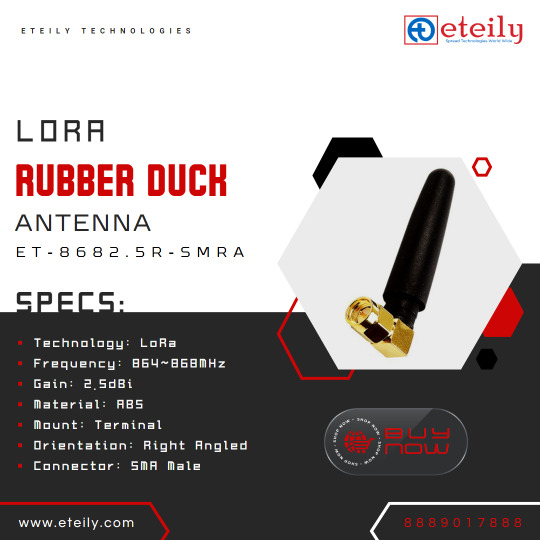
IoT LoRa antennas are designed to operate in the unlicensed Industrial, Scientific, and Medical (ISM) frequency bands, such as 868 MHz and 915 MHz, depending on the region. These antennas are designed to provide long-range communication with low power consumption, making them ideal for IoT devices that require long battery life. We are also Manufacturer and Suppliers of IoT LoRa Antenna in Delhi, Mumbai, Chennai, Hyderabad, Pune, Bangalore, Kolkata and Ahmadabad.
#IoT Lora LPWAN Antenna#IoT Lora LPWAN antenna in india#IoT Lora LPWAN antenna manufactures#IoT Lora LPWAN antenna manufactures in india#IoT Lora LPWAN antenna suppliers in india#IoT Lora LPWAN antenna wholesalers in india#manufactures of IoT Lora LPWAN antenna#suppliers of IoT Lora LPWAN antenna#wholesalers of IoT Lora LPWAN antenna#IoT Lora LPWAN antenna in Ahmedabad#IoT Lora LPWAN antenna in delhi#IoT Lora LPWAN antenna in mumbai#IoT Lora LPWAN antenna in chennai#IoT Lora LPWAN antenna in bangalore#IoT Lora LPWAN antenna in bangaluru#IoT Lora LPWAN antenna in Hyderabad#IoT Lora LPWAN antenna in Kolkata#IoT Lora LPWAN antenna in Pune#Suppliers In Ahmedabad#IoT Lora LPWAN antenna in ahmedabad price#best IoT Lora LPWAN antenna in ahmedabad#IoT Lora LPWAN ahmedabad#IoT Lora LPWAN antenna price#IoT Lora LPWAN Antenna at Best Price in India#IoT Lora LPWAN antenna manufacturers in delhi#IoT Lora LPWAN antenna manufacturers in mumbai#IoT Lora LPWAN antenna manufacturers in chennai#IoT Lora LPWAN antenna manufacturers in bangalore#IoT Lora LPWAN antenna manufacturers in hyderabad#IoT Lora LPWAN antenna manufactures in kolkata
0 notes
Text
0 notes
Text

Eteily Technologies India Pvt. Ltd.
5G 3dBi Rubber Duck Antenna With SMA Male Movable Connector
SKU: ET-5G3R-SMMO
For More Info -
9343643799
#rubber duck antenna#best rubber duck antenna#rf antenna#5g antenna#rf antenna in telecom#rf antenna manufacturers
0 notes
Text
LoRa devices from MOKOSmart
An estimated 70 million devices are expected to be connected to the Internet and exchange data by 2020. From the coffee machine to the doorbell to the pill box: Connected devices that talk to apps and online services have so far been part of the realm of visions of the future. Lorawan stands for “long range wide area network” and is a radio network with a wide range and small energy requirement. Although they can only transmit tiny amounts of data – images are already eliminated – Lora devices can work for miles and can do with a small battery for years. The chips are small like a two-franker, thus fit into everyday objects and are at the same time cheap – around ten francs. This makes them ideal for bringing devices to the grid at a reasonable price. Small sensors or switches could soon appear in all everyday areas, in flowerbeds as well as on letterboxes or bicycles.
How much do you know about LoRa technology and NB-IoT?
As a low-power WAN communication technology, LoRa offers cost-effective solutions for battery-powered IoT applications. Because of these technical characteristics, the LoRa network consists mainly of terminals (built-in LoRa module), gateway (or base station), server (server), and cloud. The most important point is that application data can achieve bidirectional transmission, easily integrated into existing network infrastructures for greater coverage than cellular cellular cellular networks, while technology has end-to-end AES128 encryption to track assets without GPS.
In contrast, NB-IoT (narrowband Internet of Things, also known as the Narrowband Internet of Things), is a standard defined by the 3GPP standardization organization, which develops a narrowband radio frequency technology for the Internet of Things. NB-IoT is more dominant for completing real-time, large amounts of data.
The application of the Internet of Things must take into account many factors, such as network costs, battery life, data transfer rate (throughput), network coverage and type of use, it is clear NB-IoT and LoRa two technologies have different technical characteristics, wide coverage, low speed, low cost, low power consumption and other features that are suitable for applications with low power consumption in the Internet of Things, and they also actively expand their own ecosystems.
At communication distance, NB-IoT compared to other low-frequency wide-area propagation technology can achieve the link budget 20dB increase in open environment, signal coverage can be increased seven times. Among them, 20dB corresponds to the loss of the signal through the outer wall of the building. Coverage of NB-IoT in the indoor environment is relatively better, and the overall communication distance can reach 15km. LoRa can provide a maximum connection budget of 168dB. In general, the range of wireless distance is 1-2 km in the city and 20 km in the suburbs.
We have successfully iterated to Use LoRa devices and Radio Frequency Technology (LoRa Technology) into our smart bike locks that complement their licensed spectrum connectivity options for full network connectivity, even in remote areas and densely populated buildings. MOKOSmart is a pioneer in the field of the Internet of Things (IoT) and has led the application of NB-IoT, NFC, BLE and other IoT technologies. Omni is integrated in the products of wireless communication, artificially specialized intelligent, sensor technology, which is a national high-tech company, integrated the development of hardware, software and system solutions.
Development history of LoRa devices
Hackers want a network for all
From a very different point of view, a growing number of tinkerers are approaching the subject, who would rather see a free, universally accessible Internet of Things. The idea of the Dutchman Wienke Giezeman has been kicked off. The Internet entrepreneur from Amsterdam has launched a foundation with the Things Network, which Lora wants to democratize. The intention: to build a free alternative in addition to commercial networks. With a swarm financing, one is currently looking for patrons who receive hardware for donations. The Kickstarter campaign has already exceeded its funding target of €150,000.
First, the networked technology is made possible by a peculiarity of Lora devices: The costs per connected device are vanishingly low compared to other network technologies. For example, a so-called gateway, connected to the Internet in a private apartment, can bring up to 10,000 radios online within a radius of several kilometers. Such a gateway currently costs around 200 Swiss francs, and the trend is falling. Unlike mobile phones, such a small group of volunteers can connect an entire city with little money. “I’m excited about this opportunity,” says Gonzalo Casas, who is working for the Things Network in Zurich. In his spare time, the software developer builds the Internet of Things for Zurich with office colleagues and other interested parties. Two LoRa gateways are already in place, and seven more are expected to be added across the city over the next few months.
The nerds still rule
The Things Network is still a matter for computer scientists. “Hackers now have to build the infrastructure, which clears the way for users,” says Casas. The Kickstarter campaign from Amsterdam is also to build a bridge here. The hope of the supporters is a kind of Apple effect: The Dutch want to make the hitherto unwieldy and complicated technology accessible – with simple operation and appealing device designs.
Low Power Wide Area Networks (LPWAN) are suitable for sending small amounts of data over a long distance. They consume little energy and ensure long battery life.
The LoRa Alliance, an open, nonprofit organization, drives the standardization of LoRa technology because it can be used safely and economically for many IoT applications. LoRa Alliance certification requires LoRa-certified devices to meet the functional requirements of LoRaWAN protocol specifications, which is confirmed by a successful test against the LoRa Certification Program.
The accredited test laboratories of 7 layers in Ratingen have been one of the first independent 3rd party laboratories in Europe to receive the authorization to carry out tests under the LoRa test and certification program.
We offer a comprehensive portfolio for LoRa devices manufacturers and smart IoT service providers:
•LoRa Alliance Test & Certification •Regulatory testing and type approvals •Technical support and testing to improve antenna and radio performance •IoT Services Services: Consulting, Acceptance Program Development, and End-to-End Verification
Full connectedness for the Internet of Things
LoRa devices: Cost advantage Flexibility
But it is not only the SIM cards that need to change but also the mobile operators. Given the different functioning of the devices, traditional contract models no longer make sense. In the future, it will be essential to make flexible offers to the customer that can be tailored to their requirements. For medium-sized enterprises in particular, the savings could not be negligible thanks to such individual contract offers. Finally, it makes a difference whether sensors should check the condition of a product in a truck loading room in real-time or passengers in coaches should stream films in HD format.
Providers have therefore set up their own departments, whose employees deal exclusively with IoT or Industry 4.0 and prepare corresponding offers. But this applies not only in connection with SIM cards but also with LoRa applications. If the volume of data to be sent is small, they are a good alternative. These LoRa devices send and receive data only at predetermined times, keeping energy consumption low. Ideal for traffic management: Street lighting could be based on traffic, for example, so that lanterns only consume energy when vehicles are actually on the road. Parking spaces can also be better managed: LoRa communication would allow cars to be used in an orderly manner to create a free parking space, which could optimize utilization rates.
Connectivity is what the customer makes of it
To optimize connectivity, developers and providers need to critically assess what type of connection is needed and what is best for them. Every situation requires a suitable solution – which also depends on other aspects, such as bandwidth, the location where the application is used, as well as the respective sales and business model.
In addition to local IoT solutions for WiFi, developers and providers should also be able to use other technologies that are just as essential to M2M connectivity. 2G, 3G, and 4G networks are already playing an important role and LoRa devices will soon become more widely used. This will provide a suitable technology for every possible IoT application. In other words, connectivity is what the user makes of it.
LoRa devices from MOKOSmart
MOKOSmart, which has located connected LoRa devices as a future business area and operates test networks in Shenzhen, China, is also one of those interested. Flory heads the sales department M2M (machine to machine) at Shenzhen. He sees Lora technology on the verge of gaining a broad foothold. It is high time for device manufacturers to have the Internet of Things on their screens: “If you don’t deal with it yet, it will be hard to catch up.” The telecommunications service is at the heart of building networks and bringing together key players, from chip manufacturers to software developers and service providers. “We are in a good position to drive forward the development of the infrastructure to more LoRa devices,” says Florry.
LoRaWAN gateway with LoRaWAN server functionality
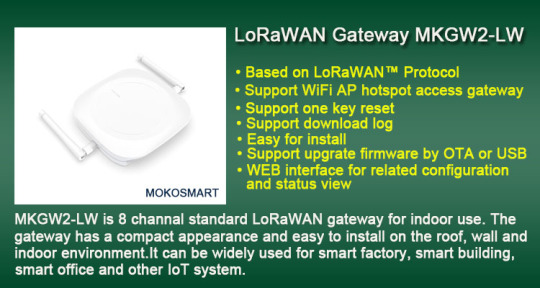
MOKOSmart offers the LoRaWAN Gateway MKGW2-LW for LoRaWAN technology as a solution for building autonomous, provider-independent networks in the license-free 868 MHz ISM band.
The Gateway MKGW2-LW, which is suitable for LoRaWAN technology, is also suitable for applications with FSK modulation. In addition to the traditional packet forwarder mode, it also has LoRaWAN server functionality (LoRa WAN Class A & C 1.0.2 EU), which eliminates the need for the additional setup of a LoRa server. Other features include the small dimensions of 75 x 75 x 25 mm, an external SMA antenna port, an Ethernet network connection and the supply of 5 V/0.5 A via micro USB cable.
LoRaWAN gateway with efficient 8-channel LoRaWAN solution
The LoRaWAN gateway can be used to implement an efficient 8-channel LoRa solution, which can also be configured via a remote JAVA application. Up to 100 LoRa devices can be managed. The MKGW2-LW is also available as an outdoor version.
Introducing the world’s first open-value-chain LoRaWAN IoT network
The first phase of a project underway in Shenzhen.
MOKOSmart, an industry leader in the field of large low power wide area networks (LPWAN), announced today that two more national LoRaWAN networks are planned: in cooperation with telecommunications and IT provider, the service provider and pioneer in wireless broadband, media, and corporate IT infrastructure.
“The networks show that LPWA technology can not only be transformative but also offers groundbreaking opportunities for the economy that could not otherwise be presented.”
The introduction of the open-value-chain IoT network is unique in the world. To deliver this groundbreaking business proposal, we are upgrading the LoRa network to provide second-generation multi-use IoT connectivity across the country, as well as LoRa devices and wireless technology to provide high-quality geolocation services.
“The upgrade of the existing LoRaWAN™ radio network with new base stations and the subsequent nationwide rollout will be a good deal as we integrate a large part of the LPWAN gateways into existing wireless broadband locations.”
With support, we have started to launch the nationwide LoRaWAN network. Successful tests were carried out, where full coverage will also be achieved as the first phase of the project.
0 notes
Text
Chip Antenna Market 2019-2023: Historical Analysis, Opportunities and Strong Growth in Future
Chip Antenna Market - Overview
Chip Antenna Market 2019 Research Report – Global Industry Forecast to 2023, is latest research report on Global Chip Antenna Market industry published by Market Research Future. Report provides comprehensive information on Global Chip Antenna Market forecast, historic data, with business development strategies, upcoming opportunities, and regional outlook. Global chip Antenna market is expected to generate a market value of USD 6 billion by 2023 growing at a CAGR of ~15%.
The major factors that contribute to the growth of global chip antenna market include the high demand for consumer electronics and increasing adoption of technologies such as automation, connected cars, Internet of Things (IoT), and smart grid. However, some constraints that can hinder the market growth are the complex design of chip antennas and compatibility issues during the chip antenna’s integration on the circuit board.
Get Free Sample of Chip Antenna Market Report @ https://www.marketresearchfuture.com/sample_request/1582
Antenna is one of the key components of radio frequency systems. Proper selection of antenna can enhance the system performance, cost efficiency, and can make the equipment size compact. There are majorly three types of antennas available in the market: chip antennas, PCB antennas, and whip antennas. Chip antennas are the smallest in size as compared to other types and can be integrated on circuit boards and radiate electromagnetic waves of high frequency. These antennas have a high-frequency range and are suitable for devices such as Wi-Fi routers and mobile phones. Chip antennas support frequency below 1GHz and can be accommodated on circuit boards even with limited space availability.
Key Players
The key players in the global chip antenna market include Antenova M2M (UK), Fractus Antennas (Spain), Johanson Technology Inc. (USA), Mitsubishi Materials (Japan), Pulse Electronics (USA), Partron Co. Ltd. (South Korea), Taoglas (Ireland), Vishay Intertechnology Inc. (USA), and Yageo Corporation (Taiwan).
Segmentation
The global chip antenna market is segmented into various segments on the basis of type, applications, and end-users. By type, the market is sub-segmented into ceramic multilayer chip antennas and dielectric chip antenna. By application, the market is segmented into WLAN, ZigBee, Bluetooth, and ISM among others. Whereas, on the basis of end user, the market is segmented into BFSI, transportation, manufacturing, industrial, government, IT & telecommunication, healthcare, and others.
Industry News
July 19, 2018 The antenna for IoT: NB-IoT, LoRa, Zigbee or Sigfox
Fractus Antennas SL has developed an antenna chip component named as the RUN mXTEND. RUN mXTEND. This is developed for providing full connectivity among IoT devices working on different frequency bands. With these antennae, a user can choose the operation frequency of the antenna to connect with. Thus, one antenna and can work on any IoT frequency band.
May 24, 2017 Antenova launches Grandis – a smaller antenna for the growing LPWAN market, IoT and smart cities
Anenova Ltd. had launched an antenna named as Grandis that works on 863-870MHz / 902-928MHz ISM bands due to increase in requirement of LPWAN market, IoT and smart cities. Grandis is a low-profile antenna that utilizes a ground plane to radiate electromagnetic waves and is designed to be in the corner of the PCB. These can be used in scientific and medical applications, industries, smart metering, manufacturing automation, network devices, agricultural and environmental monitoring and consumer tracking, globally.
July 2018, Fractus Antennas, a leading designer and manufacturer of chip antennas, introduced an antenna booster solution named as “ALL mXTEND (FR01-S4-220)”. The solution is categorized under the company’s patented Virtual Antenna Technology and supports multiband performance of wireless devices.
December 2017, Antenova Ltd. issued a product brief for its “GNSS Antenna, part number M20047-1” named Active Sinica. This antenna is compact in size, can be easily integrated with tracking devices such as telematics and wearable sports devices and used in environments where there is a restricted view of the sky and line of sight.
Access Chip Antenna Market Report Details @ https://www.marketresearchfuture.com/reports/chip-antenna-market-1582
Regional analysis
The global market for chip antenna is estimated to grow at a significant rate during the forecast period from 2018 to 2023. The geographical analysis of the chip antenna market is done for North America, Europe, Asia-Pacific, and the rest of the world.
Asia-Pacific is expected to dominate the chip antenna market during the forecast period. The major factors influencing the market in this region are expanding consumer electronics industry and increasing adoption of automation. North America is also expected to grow at a significant pace due to early adoption of advanced technologies such as Wi-Fi, ZigBee, and others. Also, well-established economies such as the US, and Canada, are spending a large share on research and development of wireless transmission technologies, which is expected to fuel the market growth of chip antennas in the region.
About Market Research Future:
At Market Research Future (MRFR), we enable our customers to unravel the complexity of various industries through our Cooked Research Report (CRR), Half-Cooked Research Reports (HCRR), Raw Research Reports (3R), Continuous-Feed Research (CFR), and Market Research & Consulting Services.
Contact:
Market Research Future
+1 646 845 9312
Email: [email protected]
0 notes
Text
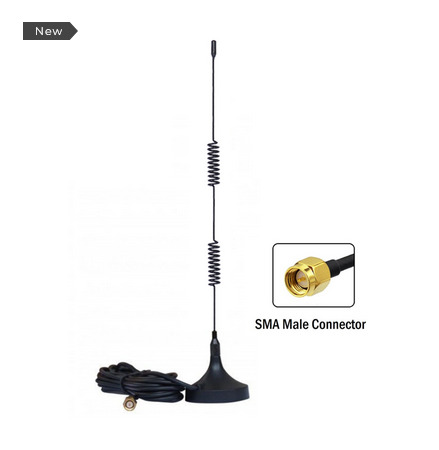
868MHz LoRa 9dBi Spring Magnetic Antenna with RG174 Cable ( L - 3Mtr) + SMA (M) Connector
A 868MHz LoRa (Long Range) 9dBi Spring Magnetic Antenna is a specific type of antenna designed for use with LoRa devices that operate at a frequency of 868MHz. Let's break down the key components of this description:
868MHz: This refers to the operating frequency of the LoRa devices. LoRa is a wireless communication technology designed for long-range and low-power applications, and 868MHz is one of the common frequency bands used for LoRa communication in Europe.
LoRa: LoRa (Long Range) is a type of low-power, wide-area networking (LPWAN) technology used for IoT (Internet of Things) and M2M (Machine-to-Machine) communication. It allows devices to transmit data over long distances with minimal power consumption.
9dBi: This is a measure of antenna gain, which quantifies the ability of the antenna to focus or concentrate the radiated energy in a particular direction. A 9dBi gain indicates that the antenna has relatively high gain, which can extend the range and improve signal strength for LoRa devices.
Spring Magnetic Antenna: This refers to the physical design of the antenna. A spring magnetic antenna typically has a spring-like or coiled structure, and it's equipped with a magnet at its base, which allows it to be easily attached to a metal surface. This magnetic mounting makes it convenient to install on vehicles or other metallic objects.
In summary, a 868MHz LoRa 9dBi Spring Magnetic Antenna is a specialized antenna designed to enhance the performance of LoRa devices operating at 868MHz by increasing signal gain and making it easy to attach to metal surfaces for better reception. It's commonly used in applications such as IoT, telemetry, and remote monitoring where long-range communication is essential. Read More
#IoT Lora LPWAN Antenna#IoT Lora LPWAN antenna in india#IoT Lora LPWAN antenna manufactures#IoT Lora LPWAN antenna manufactures in india#IoT Lora LPWAN antenna suppliers in india#IoT Lora LPWAN antenna wholesalers in india#manufactures 5G Internal in pune#suppliers of PCB Antenna#wholesalers of Screw mount Antenna#Spring Magnetic Antenna in Ahmedabad#IoT Lora LPWAN antenna in delhi#Rubber Magnetic Antenna in mumbai#IoT Lora LPWAN antenna in chennai#IoT Lora LPWAN antenna in bangalore#IoT Lora LPWAN antenna in bangaluru#IoT Lora LPWAN antenna in Hyderabad#IoT Lora LPWAN antenna in Kolkata#IoT Lora LPWAN antenna in Pune#Wi-Fi 5dBi Screwable Puck Antenna Suppliers In Ahmedabad#IoT Lora LPWAN antenna in ahmedabad price#best manufactures Combo Screw Mount Antenna in ahmedabad#IoT Lora LPWAN ahmedabad#IoT Lora LPWAN antenna price#IoT Lora LPWAN Antenna at Best Price in India#IoT Lora LPWAN antenna manufacturers in delhi#IoT Lora LPWAN antenna manufacturers in mumbai#IoT Lora LPWAN antenna manufacturers in chennai#IoT Lora LPWAN antenna manufacturers in bangalore#IoT Lora LPWAN antenna manufacturers in hyderabad#IoT Lora LPWAN antenna manufactures in kolkata
0 notes
Text
IoT LoRa LPWAN
ETEILY make LoRa Antenna's are high-performance, high gain, best quality. Eteily provides LoRa Antenna for External, Internal and outdoor gateway's. LoRa Antenna frequency includes 915MHz, 868MHz, 433MHz, 410MHz, 865MHz, etc. We provide LoRa LPWAN Gateway Antenna, Helium Minor Antenna all over the world.
IoT LoRa LPWAN antennas are designed to enable long-range communication with IoT devices using the LoRaWAN protocol. LoRaWAN antenna helium technology is designed for low-power, long-range communication, and LoRaWAN is one of the most popular LPWAN protocols.
Download Catalogues
High gain IoT antenna is a critical component of an IoT LoRa LPWAN system, as it is responsible for transmitting and receiving signals to and from the IoT devices. Best LoRa antenna typically operates at the Industrial, Scientific, and Medical (ISM) frequency bands, which are unlicensed frequency bands, and has a range of several kilometers. We are also manufacturer and suppliers of RF antenna in Delhi, Mumbai, Chennai, Hyderabad, Pune, Bangalore, Kolkata and Ahmadabad.
#IoT Lora LPWAN Antenna#IoT Lora LPWAN antenna in india#IoT Lora LPWAN antenna manufactures#IoT Lora LPWAN antenna manufactures in india#IoT Lora LPWAN antenna suppliers in india#IoT Lora LPWAN antenna wholesalers in india#manufactures 5G Internal in pune#suppliers of PCB Antenna#wholesalers of Screw mount Antenna#Spring Magnetic Antenna in Ahmedabad#IoT Lora LPWAN antenna in delhi#Rubber Magnetic Antenna in mumbai#IoT Lora LPWAN antenna in chennai#IoT Lora LPWAN antenna in bangalore#IoT Lora LPWAN antenna in bangaluru#IoT Lora LPWAN antenna in Hyderabad#IoT Lora LPWAN antenna in Kolkata#IoT Lora LPWAN antenna in Pune#Wi-Fi 5dBi Screwable Puck Antenna Suppliers In Ahmedabad#IoT Lora LPWAN antenna in ahmedabad price#best manufactures Combo Screw Mount Antenna in ahmedabad#IoT Lora LPWAN ahmedabad#IoT Lora LPWAN antenna price#IoT Lora LPWAN Antenna at Best Price in India#IoT Lora LPWAN antenna manufacturers in delhi#IoT Lora LPWAN antenna manufacturers in mumbai#IoT Lora LPWAN antenna manufacturers in chennai
0 notes
Text
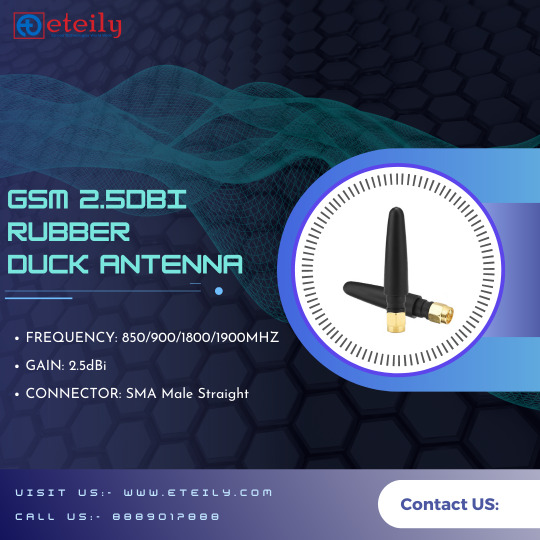
GSM 2.5dBi Rubber Duck Antenna Manufacturers Antenna 2023
IoT LoRa LPWAN
ETEILY make LoRa Antenna's are high-performance, high gain, best quality. Eteily provides LoRa Antenna for External, Internal and outdoor gateway's. LoRa Antenna frequency includes 915MHz, 868MHz, 433MHz, 410MHz, 865MHz, etc. We provide LoRa LPWAN Gateway Antenna, Helium Minor Antenna all over the world.
IoT LoRa LPWAN antennas are designed to enable long-range communication with IoT devices using the LoRaWAN protocol. LoRaWAN antenna helium technology is designed for low-power, long-range communication, and LoRaWAN is one of the most popular LPWAN protocols.
#IoT Lora LPWAN Antenna#IoT Lora LPWAN antenna in india#IoT Lora LPWAN antenna manufactures#IoT Lora LPWAN antenna manufactures in india#IoT Lora LPWAN antenna suppliers in india#IoT Lora LPWAN antenna wholesalers in india#manufactures 5G Internal in pune#suppliers of PCB Antenna#wholesalers of Screw mount Antenna#Spring Magnetic Antenna in Ahmedabad#IoT Lora LPWAN antenna in delhi#Rubber Magnetic Antenna in mumbai#IoT Lora LPWAN antenna in chennai#IoT Lora LPWAN antenna in bangalore#IoT Lora LPWAN antenna in bangaluru#IoT Lora LPWAN antenna in Hyderabad#IoT Lora LPWAN antenna in Kolkata#IoT Lora LPWAN antenna in Pune#Wi-Fi 5dBi Screwable Puck Antenna Suppliers In Ahmedabad#IoT Lora LPWAN antenna in ahmedabad price#best manufactures Combo Screw Mount Antenna in ahmedabad#IoT Lora LPWAN ahmedabad#IoT Lora LPWAN antenna price#IoT Lora LPWAN Antenna at Best Price in India#IoT Lora LPWAN antenna manufacturers in delhi#IoT Lora LPWAN antenna manufacturers in mumbai#IoT Lora LPWAN antenna manufacturers in chennai#IoT Lora LPWAN antenna manufacturers in bangalore#IoT Lora LPWAN antenna manufacturers in hyderabad#IoT Lora LPWAN antenna manufactures in kolkata
0 notes
Text
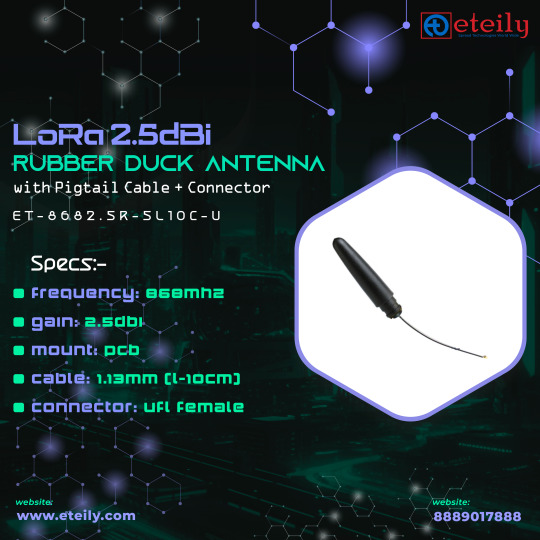
LORa 2.5dBi Rubber Duck Antenna
IoT LoRa LPWAN
ETEILY make LoRa Antenna's are high-performance, high gain, best quality. Eteily provides LoRa Antenna for External, Internal and outdoor gateway's. LoRa Antenna frequency includes 915MHz, 868MHz, 433MHz, 410MHz, 865MHz, etc. We provide LoRa LPWAN Gateway Antenna, Helium Minor Antenna all over the world.
IoT LoRa LPWAN antennas are designed to enable long-range communication with IoT devices using the LoRaWAN protocol. LoRaWAN antenna helium technology is designed for low-power, long-range communication, and LoRaWAN is one of the most popular LPWAN protocols.
Download Catalogues
High gain IoT antenna is a critical component of an IoT LoRa LPWAN system, as it is responsible for transmitting and receiving signals to and from the IoT devices. Best LoRa antenna typically operates at the Industrial, Scientific, and Medical (ISM) frequency bands, which are unlicensed frequency bands, and has a range of several kilometers. We are also manufacturer and suppliers of RF antenna in Delhi, Mumbai, Chennai, Hyderabad, Pune, Bangalore, Kolkata and Ahmedabad.
There are different types of IoT antennas manufacturer, including omnidirectional antennas, which can receive and transmit signals in all directions, and directional antennas, which have a focused beam that can reach a specific area. The choice of antenna will depend on the specific requirements of the application, including the distance, data rate, and number of devices to be connected.
#IoT Lora LPWAN Antenna#IoT Lora LPWAN antenna in india#IoT Lora LPWAN antenna manufactures#IoT Lora LPWAN antenna manufactures in india#IoT Lora LPWAN antenna suppliers in india#IoT Lora LPWAN antenna wholesalers in india#manufactures 5G Internal in pune#suppliers of PCB Antenna#wholesalers of Screw mount Antenna#Spring Magnetic Antenna in Ahmedabad#IoT Lora LPWAN antenna in delhi#Rubber Magnetic Antenna in mumbai#IoT Lora LPWAN antenna in chennai#IoT Lora LPWAN antenna in bangalore#IoT Lora LPWAN antenna in bangaluru#IoT Lora LPWAN antenna in Hyderabad#IoT Lora LPWAN antenna in Kolkata#IoT Lora LPWAN antenna in Pune#Wi-Fi 5dBi Screwable Puck Antenna Suppliers In Ahmedabad#IoT Lora LPWAN antenna in ahmedabad price#best manufactures Combo Screw Mount Antenna in ahmedabad#IoT Lora LPWAN ahmedabad#IoT Lora LPWAN antenna price#IoT Lora LPWAN Antenna at Best Price in India#IoT Lora LPWAN antenna manufacturers in delhi#IoT Lora LPWAN antenna manufacturers in mumbai#IoT Lora LPWAN antenna manufacturers in chennai#IoT Lora LPWAN antenna manufacturers in bangalore#IoT Lora LPWAN antenna manufacturers in hyderabad#IoT Lora LPWAN antenna manufactures in kolkata
0 notes
Text
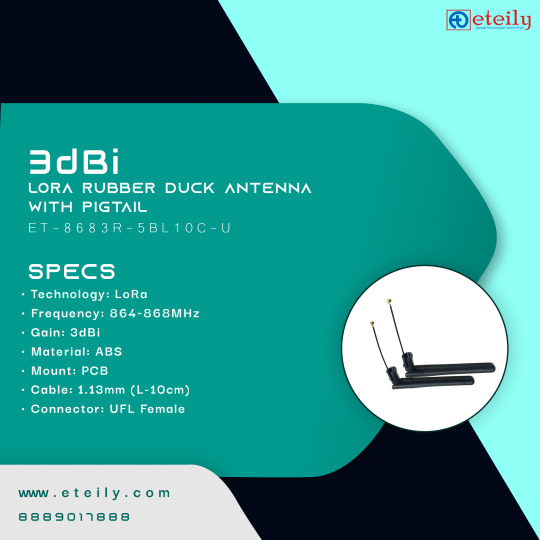
3dBi LoRa Rubber Duck Antenna with Pigtail
IoT LoRa Antenna
Eteily IoT LoRa Antenna (standing for Long Range Antenna) is a LPWAN Technology, considered by a long range connected to a low power consumption. It is a technology that can be parameterized to change its range and data rate, manipulating its power consumption. It is usually provided with its integrated MAC layer called LoRaWAN, offering IoT-oriented devices management. IOT ISM LORA Helium Antenna manufacturer in India, We supply product World Wide.
An IoT LoRa antenna is a specialized antenna designed to work with IoT devices that use the LoRaWAN protocol. LoRaWAN is a low-power, long-range wireless communication protocol that is used in a variety of IoT applications, such as smart cities, agriculture, and industrial automation.
IoT LoRa antennas are designed to operate in the unlicensed Industrial, Scientific, and Medical (ISM) frequency bands, such as 868 MHz and 915 MHz, depending on the region. These antennas are designed to provide long-range communication with low power consumption, making them ideal for IoT devices that require long battery life. We are also Manufacturer and Suppliers of IoT LoRa Antenna in Delhi, Mumbai, Chennai, Hyderabad, Pune, Bangalore, Kolkata and Ahmadabad.
There are two main types of IoT LoRa antennas: omnidirectional and directional. Omnidirectional antennas are designed to send and receive signals in all directions, while directional antennas have a focused beam that can reach a specific area. The choice of antenna will depend on the specific requirements of the application, including the distance, data rate, and number of devices to be connected.
#IoT Lora LPWAN Antenna#IoT Lora LPWAN antenna in india#IoT Lora LPWAN antenna manufactures#IoT Lora LPWAN antenna manufactures in india#IoT Lora LPWAN antenna suppliers in india#IoT Lora LPWAN antenna wholesalers in india#manufactures 5G Internal in pune#suppliers of PCB Antenna#wholesalers of Screw mount Antenna#Spring Magnetic Antenna in Ahmedabad#IoT Lora LPWAN antenna in delhi#Rubber Magnetic Antenna in mumbai#IoT Lora LPWAN antenna in chennai#IoT Lora LPWAN antenna in bangalore#IoT Lora LPWAN antenna in bangaluru#IoT Lora LPWAN antenna in Hyderabad#IoT Lora LPWAN antenna in Kolkata#IoT Lora LPWAN antenna in Pune#Wi-Fi 5dBi Screwable Puck Antenna Suppliers In Ahmedabad#IoT Lora LPWAN antenna in ahmedabad price#best manufactures Combo Screw Mount Antenna in ahmedabad#IoT Lora LPWAN ahmedabad#IoT Lora LPWAN antenna price#IoT Lora LPWAN Antenna at Best Price in India#IoT Lora LPWAN antenna manufacturers in delhi#IoT Lora LPWAN antenna manufacturers in mumbai#IoT Lora LPWAN antenna manufacturers in chennai#IoT Lora LPWAN antenna manufacturers in bangalore#IoT Lora LPWAN antenna manufacturers in hyderabad#IoT Lora LPWAN antenna manufactures in kolkata
1 note
·
View note
Text
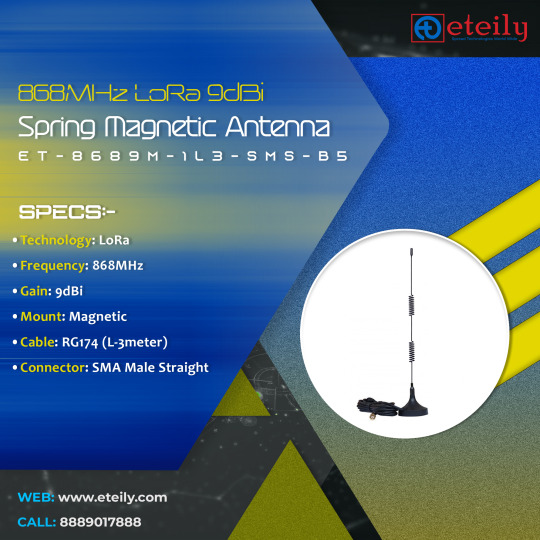
868MHz LoRa 9dBi Spring Magnetic Antenna Manufacturers
A 868MHz LoRa 9dBi spring magnetic antenna is an antenna designed for use with LoRa (Long Range) devices that operate at a frequency of 868MHz. LoRa is a low-power, long-range wireless communication technology commonly used for Internet of Things (IoT) applications.
Here's a breakdown of the specifications:
Frequency: 868MHz - This is the operating frequency of the antenna. It is optimized for LoRa devices that use this specific frequency band.
dBi (decibels-isotropic): 9dBi is the gain of the antenna. Gain is a measure of how much the antenna can focus its radiated energy in a particular direction. A higher gain generally implies a more focused and stronger signal in a specific direction.
Spring Design: The "spring" design typically means that the antenna has a flexible spring-like structure, which provides some flexibility and impact resistance. This design is useful for applications where the antenna might experience vibrations, shocks, or bending.
Magnetic Mount: The antenna comes with a magnetic base that allows it to be easily attached to metal surfaces, such as the roof of a vehicle or other equipment. The magnetic mount provides a convenient and easy-to-install solution for temporary or mobile applications.
Such an antenna would be ideal for applications where you need to extend the communication range between LoRa devices or enhance the signal strength in a particular direction. Keep in mind that antenna performance can be affected by its surroundings and placement, so it's essential to ensure it's installed correctly to achieve the best results. Additionally, check the antenna's compatibility with your specific LoRa device and its regulations in your region to avoid any legal issues.
#IoT Lora LPWAN Antenna#IoT Lora LPWAN antenna in india#IoT Lora LPWAN antenna manufactures#IoT Lora LPWAN antenna manufactures in india#IoT Lora LPWAN antenna suppliers in india#IoT Lora LPWAN antenna wholesalers in india#manufactures 5G Internal in pune#suppliers of PCB Antenna#wholesalers of Screw mount Antenna#Spring Magnetic Antenna in Ahmedabad#IoT Lora LPWAN antenna in delhi#Rubber Magnetic Antenna in mumbai#IoT Lora LPWAN antenna in chennai#IoT Lora LPWAN antenna in bangalore#IoT Lora LPWAN antenna in bangaluru#IoT Lora LPWAN antenna in Hyderabad#IoT Lora LPWAN antenna in Kolkata#IoT Lora LPWAN antenna in Pune#Screw Mount Duck Type Antenna Suppliers In Ahmedabad#IoT Lora LPWAN antenna in ahmedabad price#best manufactures Combo Screw Mount Antenna in ahmedabad#IoT Lora LPWAN ahmedabad#IoT Lora LPWAN antenna price#IoT Lora LPWAN Antenna at Best Price in India#IoT Lora LPWAN antenna manufacturers in delhi#IoT Lora LPWAN antenna manufacturers in mumbai#IoT Lora LPWAN antenna manufacturers in chennai#IoT Lora LPWAN antenna manufacturers in bangalore#IoT Lora LPWAN antenna manufacturers in hyderabad#IoT Lora LPWAN antenna manufactures in kolkata
0 notes
Text

Eteily LoRa Helical Coil Antenna Manufacturers in India 2023
IoT LoRa LPWAN
ETEILY make LoRa Antenna's are high-performance, high gain, best quality. Eteily provides LoRa Antenna for External, Internal and outdoor gateway's. LoRa Antenna frequency includes 915MHz, 868MHz, 433MHz, 410MHz, 865MHz, etc. We provide LoRa LPWAN Gateway Antenna, Helium Minor Antenna all over the world.
IoT LoRa LPWAN antennas are designed to enable long-range communication with IoT devices using the LoRaWAN protocol. LoRaWAN antenna helium technology is designed for low-power, long-range communication, and LoRaWAN is one of the most popular LPWAN protocols.
Download Catalogues
High gain IoT antenna is a critical component of an IoT LoRa LPWAN system, as it is responsible for transmitting and receiving signals to and from the IoT devices. Best LoRa antenna typically operates at the Industrial, Scientific, and Medical (ISM) frequency bands, which are unlicensed frequency bands, and has a range of several kilometers. We are also manufacturer and suppliers of RF antenna in Delhi, Mumbai, Chennai, Hyderabad, Pune, Bangalore, Kolkata and Ahmadabad.
#IoT Lora LPWAN Antenna#IoT Lora LPWAN antenna in india#IoT Lora LPWAN antenna manufactures#IoT Lora LPWAN antenna manufactures in india#IoT Lora LPWAN antenna suppliers in india#IoT Lora LPWAN antenna wholesalers in india#manufactures 5G Internal in pune#suppliers of PCB Antenna#wholesalers of Screw mount Antenna#Spring Magnetic Antenna in Ahmedabad#IoT Lora LPWAN antenna in delhi#Rubber Magnetic Antenna in mumbai#IoT Lora LPWAN antenna in chennai#IoT Lora LPWAN antenna in bangalore#IoT Lora LPWAN antenna in bangaluru#IoT Lora LPWAN antenna in Hyderabad#IoT Lora LPWAN antenna in Kolkata#IoT Lora LPWAN antenna in Pune#Screw Mount Duck Type Antenna Suppliers In Ahmedabad#IoT Lora LPWAN antenna in ahmedabad price#best manufactures Combo Screw Mount Antenna in ahmedabad#IoT Lora LPWAN ahmedabad#IoT Lora LPWAN antenna price#IoT Lora LPWAN Antenna at Best Price in India#IoT Lora LPWAN antenna manufacturers in delhi#IoT Lora LPWAN antenna manufacturers in mumbai#IoT Lora LPWAN antenna manufacturers in chennai#IoT Lora LPWAN antenna manufacturers in bangalore#IoT Lora LPWAN antenna manufacturers in hyderabad#IoT Lora LPWAN antenna manufactures in kolkata
0 notes
Text
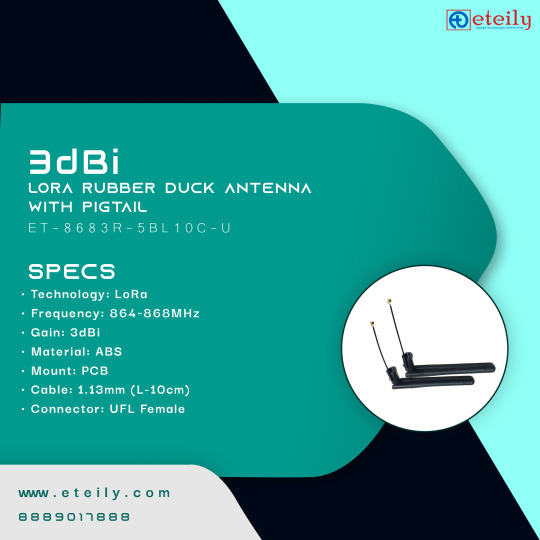
3dBI LORA RUBBER DUCK ANTENNA WITH PIGTAIL
A 3dBi LoRa rubber duck antenna with a pigtail refers to an antenna designed for LoRa (Long Range) wireless communication technology. Let's break down the different components:
LoRa: LoRa is a low-power, long-range wireless communication technology that enables long-distance data transmission with low power consumption. It is often used in applications such as Internet of Things (IoT) devices, smart agriculture, and industrial automation.
Rubber duck antenna: A rubber duck antenna is a type of omnidirectional antenna that is commonly used with portable devices due to its compact size and flexibility. It is typically made of rubber or a similar material and has a flexible whip design.
Pigtail: In the context of antennas, a pigtail refers to a short length of coaxial cable used to connect the antenna to the device. It serves as an interface between the antenna and the radio transceiver.
The "3dBi" specification indicates the antenna's gain, which measures the ability of the antenna to concentrate the radiated signal in a specific direction. A higher gain value generally means a stronger signal in that direction.
So, a 3dBi LoRa rubber duck antenna with a pigtail would be a compact, flexible antenna designed for LoRa communication, providing a gain of 3dBi. The pigtail allows for easy connection to a device with a compatible coaxial antenna connector.
#IoT Lora LPWAN Antenna#IoT Lora LPWAN antenna in india#IoT Lora LPWAN antenna manufactures#IoT Lora LPWAN antenna manufactures in india#IoT Lora LPWAN antenna suppliers in india#IoT Lora LPWAN antenna wholesalers in india#manufactures Adhesive Antenna supplier in pune#suppliers of 5dBi Adhesive Antenna#wholesalers of 915MHz 5dBi Rubber Duck Antenna#IoT Lora LPWAN antenna in Ahmedabad#IoT Lora LPWAN antenna in delhi#10dBi Fiberglass Antenna in mumbai#IoT Lora LPWAN antenna in chennai#IoT Lora LPWAN antenna in bangalore#IoT Lora LPWAN antenna in bangaluru#IoT Lora LPWAN antenna in Hyderabad#IoT Lora LPWAN antenna in Kolkata#IoT Lora LPWAN antenna in Pune#868MHz 5dBi Adhesive Antenna Suppliers In Ahmedabad#IoT Lora LPWAN antenna in ahmedabad price#best manufactures868MHz 5dBi Adhesive Antenna in ahmedabad#IoT Lora LPWAN ahmedabad#IoT Lora LPWAN antenna price#IoT Lora LPWAN Antenna at Best Price in India#IoT Lora LPWAN antenna manufacturers in delhi#IoT Lora LPWAN antenna manufacturers in mumbai#IoT Lora LPWAN antenna manufacturers in chennai#IoT Lora LPWAN antenna manufacturers in bangalore#IoT Lora LPWAN antenna manufacturers in hyderabad#IoT Lora LPWAN antenna manufactures in kolkata
0 notes
Text
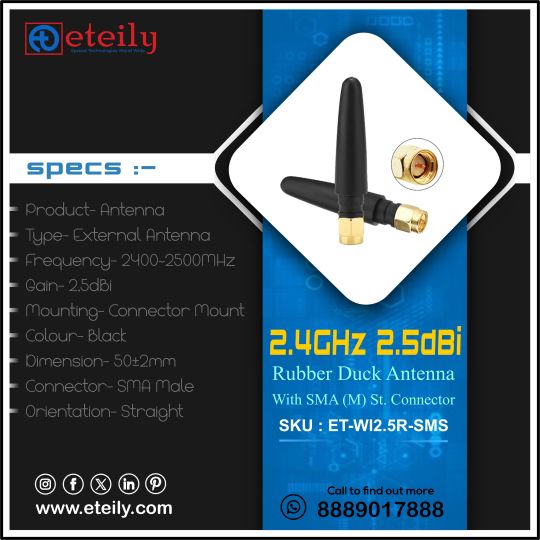
2.4GHz 2.5dBi Rubber Duck Antenna Manufacturers
A "rubber duck" antenna is a type of omnidirectional antenna commonly used in radio communication devices, such as two-way radios and Wi-Fi routers. It is named "rubber duck" due to its flexible, rubbery exterior. These antennas are typically short, stubby, and have a helical coil design.
Key characteristics of a rubber duck antenna include:
Omnidirectional Radiation Pattern: Rubber duck antennas are designed to radiate signals in all directions, providing a 360-degree coverage pattern. This makes them suitable for applications where the signal needs to be transmitted or received from various directions.
Compact Size: Rubber duck antennas are relatively short and compact compared to some other types of antennas. This makes them convenient for portable devices and equipment where space is limited.
Flexible Design: The flexibility of the rubber duck antenna allows it to withstand bending and flexing without breaking. This makes it more durable for portable and handheld devices.
Wide Usage: Rubber duck antennas are commonly used in applications such as handheld radios (walkie-talkies), portable scanners, and Wi-Fi routers. They are often detachable and can be replaced with antennas of different lengths or types for specific needs.
Frequency Range: The design of rubber duck antennas allows them to operate within specific frequency ranges. Different antennas may be optimized for different frequency bands, such as those used for VHF (Very High Frequency) or UHF (Ultra High Frequency) communication.
It's important to note that while rubber duck antennas are versatile, their performance may not be as specialized as larger or more directional antennas. The choice of antenna depends on the specific requirements of the communication system, such as range, directionality, and the frequency of operation.
#rubber duck antenna#Rubber ducky antenna#9dBi GSM Rubber Duck Antenna#3dBi Gain Rubber Duck Antenna#Rubber Duck Antennas#Rubber Duck Antenna Gsm-2 DBI#2.4 GHz Rubber Duck Omni Antennas#900 MHz 3 dBi Rubber Duck Antenna#Rubber Duck Antenna Manufacturer#High-Performance Wi-Fi Rubber Duck Antennas#4G/5G Rubber Duck Antenna#Top Rubber Duck Antenna Manufacturers#865 – 868 MHz / 1dBi Gain Rubber Duck Antenna#Rubber Duck Antenna in Mumbai#3DBI GSM rubber Duck antenna 800#External Rubber Duck Antenna#Dual Band White Rubber Duck Antenna#868 Mhz Rubber Duck Antenna#rubber duck antenna in india#rubber duck antenna in delhi#rubber duck antenna in chennai#rubber duck antenna in bangalore#rubber duck antenna in Ahmedabad#rubber duck antenna in hyderabad
0 notes
Text
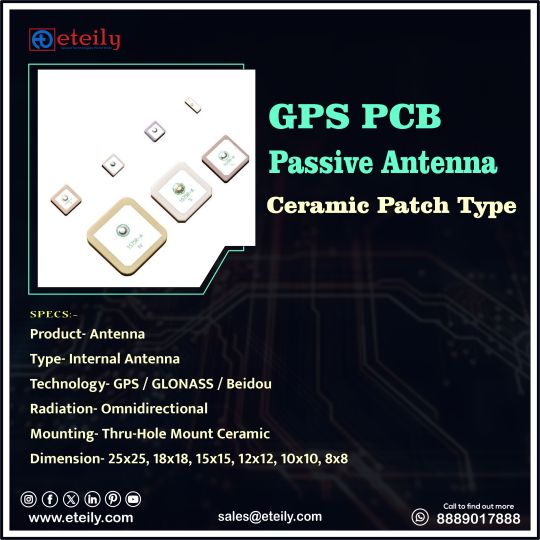
Eteily Technologies India Pvt Ltd
GPS PCB Passive Antenna Ceramic Patch Type
SPECS :
1. Product- Antenna
2. Type-Internal Antenna
3. Technology- GPS/GLONASS/Beidou
4. Radiation-Omnidirectional
5. Mounting-Thru-Hole Mount Ceramic
6. Dimension-25x25, 18x18, 15x15, 12x12, 10x10, 8x8
For More Info -
+91 88890 17888
#eteily#technologies#eteilyindia#telecom#telecommunications#gps#gpstracker#gpsantenna#pcb#india
#gps antenna#gps antenna manufacturer#gnss antenna#gps antenna for car#garmin gps antenna#garmin antenna#trimble gps antenna#gps active antenna#gps patch antenna#external gps antenna#gps antenna types#usb gps antenna#nmea 2000 gps antenna#external gps#marine gps antenna#one lap gps#iridium gps#passive gps antenna#gps antenna for ipad#tracking antenna#fakra gps antenna#neo 6m gps module with arduino#lowrance gps puck
0 notes
Text

Eteily Technologies India Pvt Ltd
ETEILY FACTORY CUSTOMIZED UFL TO UFL IPEXI.13MM RF JUMPER CABLE ASSEMBLIES
SKU: ET-U-5L20C-U
specs:-
CONNECTORI U.FL Female
CONNECTOR2:U.FL Female
CABLE TYPE :1.13mm
For More Info -
8889017888
#eteily#eteilyindia#technologies#eteilytechnologies#factory#customise#UFLTOUFL#rfjumpercable#cableassemblies#india#delhi#chennai#mumbai#kolkatta#bangalore#navratri#discount#rfantenna
#cable assembly#rf cable assembly#spiral cable assembly#integrated cable assembly#sma cable assembly#cable assembly automation#wire assembly#automated cable assembly#american standard cable assembly#cable assembly business for sale#cable assembly brazil#battery cable assembly#bnc cable assembly#cable assembly components#cable assembly companies near me#cable carrier assembly#cable custom assembly#coaxial cable assembly#copper cable assembly#cable assembly manufacturers#cable assembly power electrical#cable assembly companies#db9 cable assembly#data network cable assembly#rf cable#rf cable manufacturer#RF cable and Connectors#BNC Cable#SMA Cable#rf cable connector
0 notes